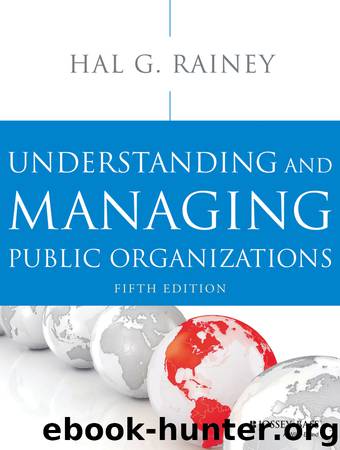Understanding and Managing Public Organizations by Hal G. Rainey

Author:Hal G. Rainey
Language: eng
Format: epub
Publisher: John Wiley & Sons
Published: 2013-12-27T16:00:00+00:00
Adams: Equity Theory.
J. Stacy Adams (1965) argued that a sense of equity in contributions and rewards has a major influence on work behaviors. A sense of inequity brings discomfort, and people therefore act to reduce or avoid it. They assess the balance between their inputs to an organization and the outcomes or rewards they receive from it, and they perceive inequity if this balance differs from the balance experienced by other employees. For example, if another person and I receive the same salary, recognition, and other rewards, yet I feel that I make a superior contribution by working harder, producing more, or having more experience, I will perceive a state of inequity. Conversely, if the other person makes superior inputs but gets lower rewards than I get, I will perceive inequity in the opposite sense; I will feel overcompensated.
In either case, according to Adams, a person tries to eliminate such inequity. If people feel overcompensated, they may try to increase their inputs or reduce their outcomes to redress the inequity. If they feel undercompensated, they will do the opposite, slowing down or reducing their contributions. Adams advanced specific propositions about how workers react that depend on factors such as whether they receive hourly pay or are paid according to their rate of production. For example, he predicted that if workers are overpaid on an hourly basis, they will produce more per hour, to reduce the feeling that they are overcompensated. If they are overpaid on a piece-rate basis, however, they will slow down, to avoid making more money than other workers.
These sorts of predictions have received some confirmation in laboratory experiments. The theory proves difficult to apply in real work settings, however, because it is hard to measure and assess inequity, and some of the concepts in the theory are ambiguous (Miner, 2005). People vary in their sensitivity to inequity, and they may vary widely in how they react to the same conditions.
Regardless of the success of this particular theory, equity in contributions and rewards figures very importantly in management. As described later, more recent models of motivation include perceptions about equity as important components. Equity issues also play a role in debates about civil service reforms and performance-based pay plans in the public sector. Governments at all levels in the United States and in other countries have tried to adopt performance-based pay plans. Supporters of such plans have often cited equity principles akin to those stressed in this theory. They have argued that people who perform better than others but receive no better pay perceive inequity and experience a loss of morale and motivation, and that the highly structured pay and reward systems in government tend to create such situations. The more recently popular alternative involves broadbanding or paybanding systems. In these systems, a larger number of pay grades and pay steps within those grades are collapsed into broader bands or categories of pay levels. Better performers can be more rapidly moved upward in pay within these bands, rather than having to go through the previous, more elaborate set of grades and steps one at a time.
Download
This site does not store any files on its server. We only index and link to content provided by other sites. Please contact the content providers to delete copyright contents if any and email us, we'll remove relevant links or contents immediately.
The Secret History by Donna Tartt(16611)
The Social Justice Warrior Handbook by Lisa De Pasquale(11486)
Thirteen Reasons Why by Jay Asher(7783)
This Is How You Lose Her by Junot Diaz(5754)
Weapons of Math Destruction by Cathy O'Neil(5032)
Zero to One by Peter Thiel(4818)
The Myth of the Strong Leader by Archie Brown(4786)
Promise Me, Dad by Joe Biden(4441)
Stone's Rules by Roger Stone(4413)
Beartown by Fredrik Backman(4405)
How Democracies Die by Steven Levitsky & Daniel Ziblatt(4393)
The Fire Next Time by James Baldwin(4338)
100 Deadly Skills by Clint Emerson(4072)
A Higher Loyalty: Truth, Lies, and Leadership by James Comey(4027)
Rise and Kill First by Ronen Bergman(4009)
The David Icke Guide to the Global Conspiracy (and how to end it) by David Icke(3876)
The Farm by Tom Rob Smith(3870)
Secrecy World by Jake Bernstein(3774)
The Doomsday Machine by Daniel Ellsberg(3726)
